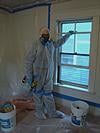
Respirators are used to clean the air inhaled by workers. Some work performed under the EPA RRP rule, depending on how it is performed, might require the use of a respirator. If not cleaned properly after use, wearing a respirator might be as dangerous if not more dangerous than not wearing one at all. The following Respirator Cleaning Procedures are from OSHA"s "Occupational Safety and Health Standards, Appendix B-2 to § 1910.134: Respirator Cleaning Procedures (Mandatory)"
"These procedures are provided for employer use when cleaning respirators. They are general in nature, and the employer as an alternative may use the cleaning recommendations provided by the manufacturer of the respirators used by their employees, provided such procedures are as effective as those listed here in Appendix B- 2. Equivalent effectiveness simply means that the procedures used must accomplish the objectives set forth in Appendix B-2, i.e., must ensure that the respirator is properly cleaned and disinfected in a manner that prevents damage to the respirator and does not cause harm to the user.
I. Procedures for Cleaning Respirators
A. Remove filters, cartridges, or canisters. Disassemble facepieces by removing speaking diaphragms, demand and pressure- demand valve assemblies, hoses, or any components recommended by the manufacturer. Discard or repair any defective parts.
B. Wash components in warm (43 deg. C [110 deg. F] maximum) water with a mild detergent or with a cleaner recommended by the manufacturer. A stiff bristle (not wire) brush may be used to facilitate the removal of dirt.
C. Rinse components thoroughly in clean, warm (43 deg. C [110 deg. F] maximum), preferably running water. Drain.
D. When the cleaner used does not contain a disinfecting agent, respirator components should be immersed for two minutes in one of the following:
1. Hypochlorite solution (50 ppm of chlorine) made by adding approximately one milliliter of laundry bleach to one liter of water at 43 deg. C (110 deg. F); or,
2. Aqueous solution of iodine (50 ppm iodine) made by adding approximately 0.8 milliliters of tincture of iodine (6-8 grams ammonium and/or potassium iodide/100 cc of 45% alcohol) to one liter of water at 43 deg. C (110 deg. F); or,
3. Other commercially available cleansers of equivalent disinfectant quality when used as directed, if their use is recommended or approved by the respirator manufacturer.
E. Rinse components thoroughly in clean, warm (43 deg. C [110 deg. F] maximum), preferably running water. Drain. The importance of thorough rinsing cannot be overemphasized. Detergents or disinfectants that dry on facepieces may result in dermatitis. In addition, some disinfectants may cause deterioration of rubber or corrosion of metal parts if not completely removed.
F. Components should be hand-dried with a clean lint-free cloth or air-dried.
G. Reassemble facepiece, replacing filters, cartridges, and canisters where necessary.
H. Test the respirator to ensure that all components work properly."
[63 FR 1152, Jan. 8, 1998]
Click here to view this standard and other OSHA Occupational Safety and Health Standards |  Looking for accurate information about the EPA RRP rule?
Looking for accurate information about the EPA RRP rule? 




